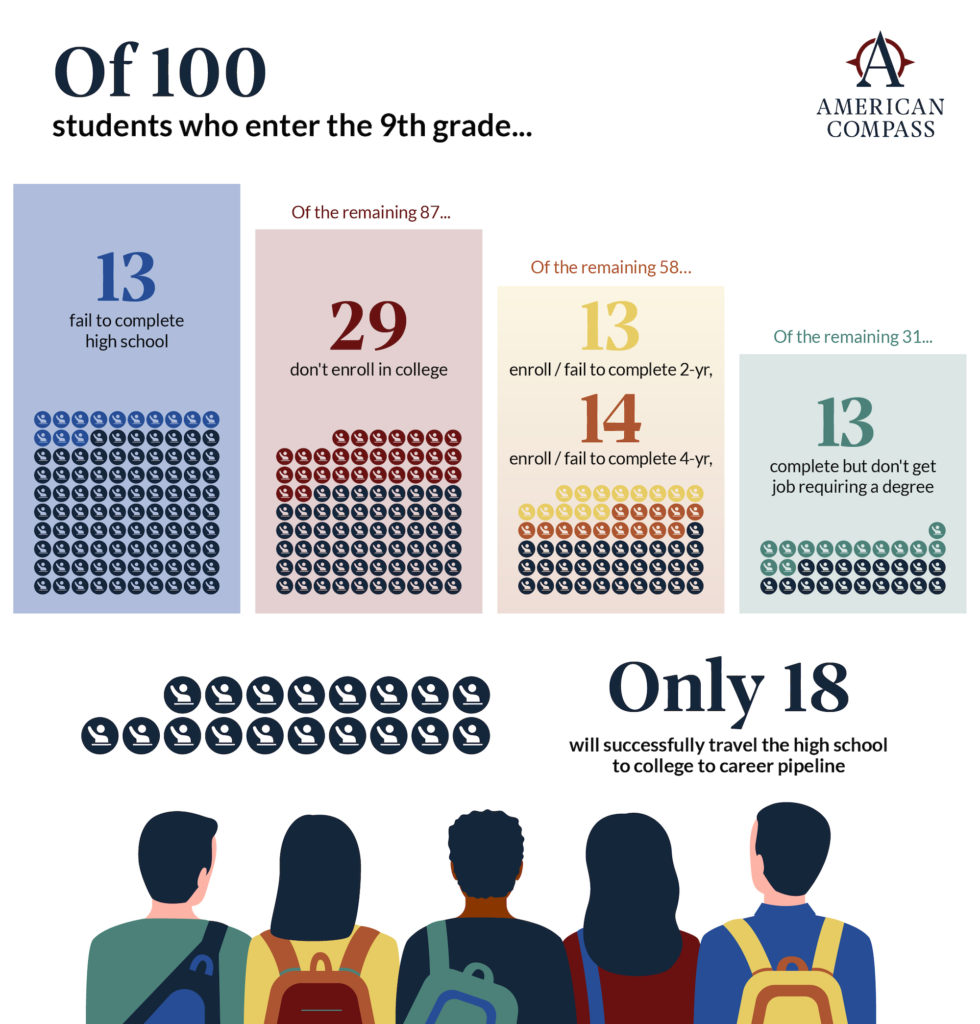

Fund on-the-job training, not just college
Read the Full Policy Paper
RECOMMENDED READING
What’s the Problem?
Public funding for post-secondary education goes almost exclusively to colleges, though most Americans do not earn degrees.
Companies hesitate to invest in job training themselves unless they, rather than workers, can reap the benefits.
America lacks effective non-college pathways and wages for workers without degrees have stagnated for decades.
College-for-All Has Failed Americans
U.S. public policy relies almost exclusively on college to prepare young men and women for productive employment. High schools operate as college-prep academies and reform focuses intensively on “college readiness.” Federal and state spending on higher education totals more than $200 billion annually and has more than doubled in recent decades. K–12 spending has surged as quickly, but the share of federal dollars allocated to career and technical education (CTE) has fallen from 11% to 3%.
But for most Americans, college is not the path to productive employment. Only half of young Americans now attain even a community college degree; among recent college graduates, 41% hold jobs that do not require a degree. All told, fewer than one in five Americans move smoothly from high school to college to career. The disconnect only widens for workers wanting or needing to begin a new career path later in life, at a stage when returning to campus with a knapsack full of books is not only ineffectual but also implausible.
What’s the Solution?
Congress should create a Workforce Training Grant—a $10,000-per-year grant to employers for each trainee engaged in on-the-job training. Funding should come out of existing higher education subsidies. The Department of Labor should be directed to:
- Define a “trainee” status for workers whose time is split between work and formal training;
- Establish the parameters that employers must define for training programs, including: responsible entity, program length, curriculum overview, completion standards, expected wage & job placement outcomes, and formal certifications earned (if any);
- Certify eligible programs and provide employers with the annual grant (up to $10,000/year per trainee employed); an
- Impose strict quality controls, including decertifying underperforming training options.
Help Employers Help Workers
Public funds rightly subsidize college because of its invaluable function preparing some young adults for productive lives. But for many people, college is the wrong institution for that role; an employer can do better. Employers know what skills are needed and how to teach them, they have the mentors and facilities in place, and they can provide direct workplace experience. Public funding should support such training just as it supports higher education. Employers, industry groups, and labor unions could all play leading roles and also enter partnerships with community colleges.

Frequently Raised Objections
“Employers will cash the checks while providing little useful training.”
Undoubtedly, there will be some ineffective programs.But workers provide an important initial check: time as a trainee has high opportunity cost, and someone can always leave a bad program for a better one. Requiring employers to pre-register their program parameters will also allow the Department of Labor to check whether programs are delivering on their self-made promise. Those that do not can be defunded.
“This is corporate welfare.”
If a trained employee’s higher productivity gets compensated with a higher wage, employers have gained little for their investment. Yet this is exactly the outcome that is in the public interest. If America wants employers to play a leading role in connecting young people to the labor force and boosting their labor-market value, it should be willing to help cover the cost.
“College is the ticket to the middle class and we should be investing in expanding access to it.”
This aspiration sounds nice, but it poorly serves the majority of Americans consistently failed by the college pathway. That pathway should remain open to those who wish to pursue it, but the nation has an obligation to invest at least as much in effective non-college pathways that can offer tickets to the middle class as well.
Further Reading
Oren Cass. “The Workforce Training Grant.” American Compass, 2022. An in-depth white paper making the case for a workforce training grant.
“A Guide to College-for-All.” American Compass, 2022. A data-driven overview of the “college-for-all” model’s failure.
Oren Cass & Richard Oyeniran. “The False Promise of Good Jobs.” American Compass, 2022. An analysis of the misalignment between the American education system and labor market.
American Workforce Act. Introduced by Senator Tom Cotton, September 2022. This bill would empower Americans to pursue non-college pathways and allow private employers to develop workforce education to support their industry’s needs, supported by a $9,000 federal voucher available to trainees.
Recommended Reading
Talkin’ (Policy) Shop: The Workforce Training Grant
On the inaugural episode of Policy in Brief, American Compass executive director Oren Cass is joined by policy director Chris Griswold to discuss the Workforce Training Grant, a proposal to create a meaningful alternative pathway to college.
The Workforce Training Grant
Public policy should recognize that employers, not universities, often provide the most socially valuable form of training and should redirect public resources accordingly.
Rebuilding from the College Catastrophe Starts Here
The problem that the American Workforce Act aims to solve is simple, but deadly serious: In American education, all roads lead to college.












